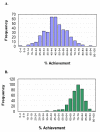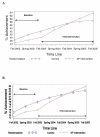Secondary prevention after coronary artery bypass graft surgery: findings of a national randomized controlled trial and sustained society-led incorporation into practice
- PMID: 21173357
- PMCID: PMC3683243
- DOI: 10.1161/CIRCULATIONAHA.110.981068
Secondary prevention after coronary artery bypass graft surgery: findings of a national randomized controlled trial and sustained society-led incorporation into practice
Abstract
Background: Despite evidence supporting the use of aspirin, β-blockers, angiotensin-converting enzyme inhibitors, and lipid-lowering therapies in eligible patients, adoption of these secondary prevention measures after coronary artery bypass grafting has been inconsistent. We sought to rigorously test on a national scale whether low-intensity continuous quality improvement interventions can be used to speed secondary prevention adherence after coronary artery bypass grafting.
Methods and results: A total of 458 hospitals participating in the Society of Thoracic Surgeons National Cardiac Database and treating 361 328 patients undergoing isolated coronary artery bypass grafting were randomized to either a control or an intervention group. The intervention group received continuous quality improvement materials designed to influence the prescription of the secondary prevention medications at discharge. The primary outcome measure was discharge prescription rates of the targeted secondary prevention medications at intervention versus control sites, assessed by measuring preintervention and postintervention site differences. Prerandomization treatment patterns and baseline data were similar in the control (n=234) and treatment (n=224) groups. Individual medication use and composite adherence increased over 24 months in both groups, with a markedly more rapid rate of adherence uptake among the intervention hospitals and a statistically significant therapy hazard ratio in the intervention versus control group for all 4 secondary prevention medications.
Conclusions: Provider-led, low-intensity continuous quality improvement efforts can improve the adoption of care processes into national practice within the context of a medical specialty society infrastructure. The findings of the present trial have led to the incorporation of study outcome metrics into a medical society rating system for ongoing quality improvement.
Figures



Comment in
-
Can we take continuous quality improvement to the next level?Circulation. 2011 Jan 4;123(1):8-9. doi: 10.1161/CIRCULATIONAHA.110.002691. Epub 2010 Dec 20. Circulation. 2011. PMID: 21173350 No abstract available.
References
-
- Deming WE. Out of the crisis. Massachusetts Institute of Technology; Boston, MA: 1986.
-
- Juran JM. The quality trilogy: A universal approach to managing for quality. ASQC 40th Annual Quality Congress; Anaheim, CA. 1986 May 20.
- Quality Progress. 1986;19:19–24.
-
- Crosby PB. Let’s talk quality: 98 questions you always wanted to ask Phil Crosby. McGraw-Hill; New York, NY: 1989.
-
- Ferguson TB, Jr, Peterson ED, Coombs LP, Eiken MC, Carey ML, Grover FL, DeLong ER, Society of Thoracic Surgeons and the National Cardiac Database Use of Continuous Quality Improvement to Increase Use of Process Measures in Patients Undergoing Coronary Artery Bypass Graft Surgery. JAMA. 2003;290:49–56. - PubMed
-
- Goyal A, Alexander JH, Hafley GE, Graham SH, Mehta RH, Mack MJ, Wolf RK, Cohn LH, Kouchoukos NT, Harrington RA, Gennevois D, Gibson CM, Califf RM, Ferguson TB, Jr, Peterson ED, PREVENT IV Investigators Outcomes associated with the use of secondary prevention medications after coronary artery bypass graft surgery. Ann Thorac Surg. 2007;83:993–1001. - PubMed
Publication types
MeSH terms
Substances
Grants and funding
LinkOut - more resources
Full Text Sources
Medical

